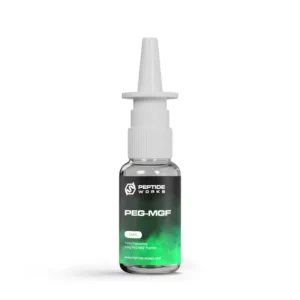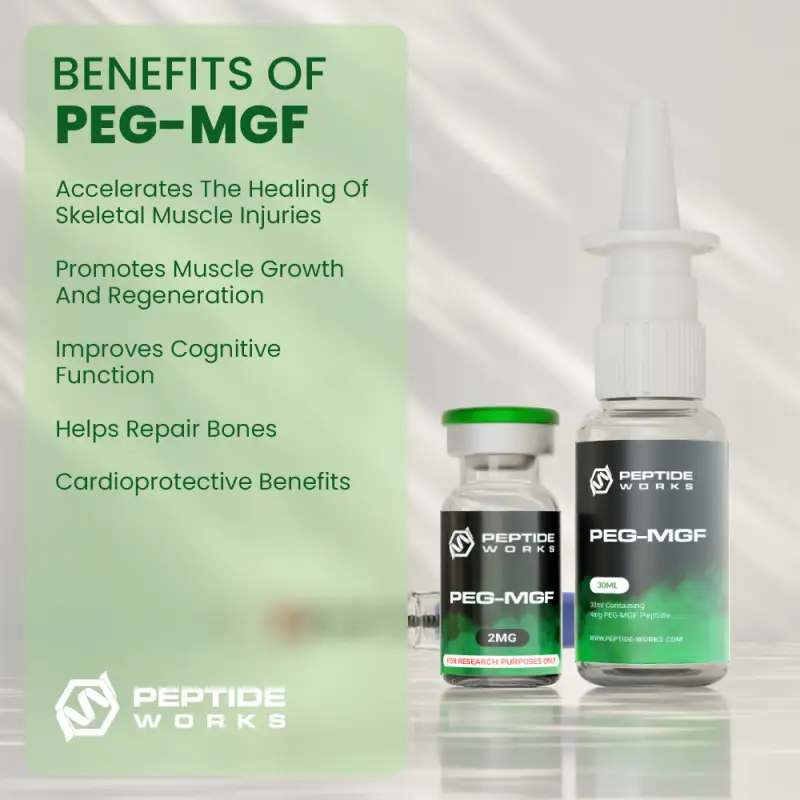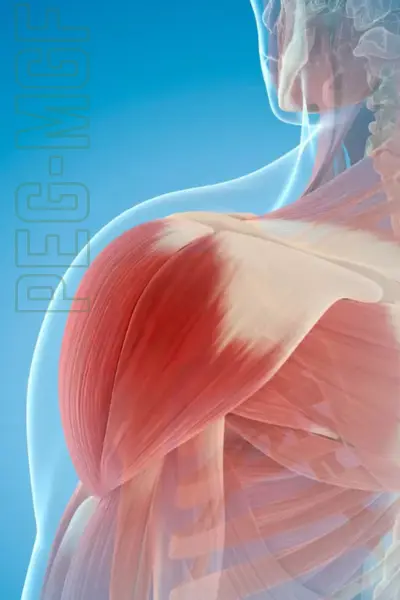PROMO!
First order? Get 10% OFF with this code: 1storder
Our Product Categories



Pegylated Mechano Growth Factor, or PEG-MGF, is a synthetic peptide that is derived from Insulin-like Growth Factor-1, or IGF-1. Its purpose is to replicate the natural production of Mechano Growth Factor (MGF) in response to stress or injury to the muscles.
The chemical modification polyethylene glycol, or “PEG” in PEG-MGF, increases the stability of the peptide and lengthens its half-life in the body. This allows PEG-MGF to stay active in the bloodstream longer, making it more effective for research or therapeutic use. Researchers often study the peptide for its potential in supporting muscle repair, regeneration, and tissue recovery.
Peptide Sequence (IUPAC Condensed): H-Tyr-Gln-Pro-Pro-Ser-Thr-Asn-Lys-Asn-Thr-Lys-Ser-Gln-Arg-Arg-Lys-Gly-Ser-Thr-Phe-Glu-Glu-His-Lys-NH2
Molecular Formula: C121H200N42O39
Molecular Weight: 2888.16
View the PEG-MGF COA
View the PEG-MGF HPLC


PEG-MGF works by stimulating muscle repair and growth at the cellular level, balancing the processes of catabolism and anabolism. While the body naturally produces MGF to activate satellite cells, which drives anabolism and facilitates muscle regeneration, catabolism breaks down damaged muscle tissue when muscles are stressed or damaged.
PEG-MGF mimics this natural process, but its pegylation enhances stability, making it more effective. It increases the proliferation of satellite cells and promotes protein synthesis by binding to particular receptors on muscle cells. Muscle hypertrophy may result from this since it speeds up recovery, lessens catabolic effects, and increases anabolic activity. PEG-MGF is being researched for its potential applications in enhancing injury recovery, treating muscle-wasting disorders, and promoting overall muscle health.
Enhanced muscle recovery and repair: Studies indicate that PEG-MGF improves muscle repair and recovery by prolonging the half-life of the peptide, which permits sustained activity [1]. A splice variant of IGF-1, MGF is expressed in response to mechanical stress and stimulates satellite cells, which facilitates myoblast differentiation, proliferation, and effective muscle fiber repair [2].
According to studies, MGF promotes tendon healing and increases muscle fiber size by about 25% in animal models [3]. MGF also promotes satellite cell activation and delays muscle cell senescence, which may have therapeutic benefits for tendon repair, age-related sarcopenia, and muscle regeneration without the carcinogenic risks of IGF-1.
Increased Muscle Growth and Hypertrophy: Research indicates that PEG-MGF may enhance muscle growth and hypertrophy by promoting repair and regeneration processes. As a splice variant of IGF-1, MGF is upregulated in response to mechanical stress, stimulating satellite cell activation and myoblast proliferation. This supports muscle remodeling and potentially leads to muscle fiber hyperplasia (new fiber formation) in addition to hypertrophy [4].
While claims of improved lean body mass, strength, and endurance are largely anecdotal, studies suggest PEG-MGF’s role in enhancing myogenesis, reducing apoptosis, and supporting muscle development, making it a promising candidate for muscle growth and recovery [5].
Bone Healing: Research suggests that PEG-MGF shows potential in tissue repair beyond muscle, including bone, cartilage, tendon, and ligament regeneration. Studies in rabbits show that it accelerated bone healing by enhancing osteoblast proliferation via the MAPK-Erk1/2 pathway [6].
For cartilage repair, MGF combined with TGF-β3 in silk fibroin scaffolds improved mesenchymal stem cell recruitment and chondrogenic differentiation, promoting cartilage-like tissue regeneration [7].
Additionally, MGF protects growth plate chondrocytes from mechanical damage and enhances their migration through the RhoA/YAP signaling axis. These findings highlight PEG-MGF’s broader regenerative potential in addressing degenerative conditions and tissue injuries across various systems [8].
Cardiovascular Health: PEG-MGF shows potential benefits for cardiovascular health, particularly in post-myocardial infarction recovery. Studies reveal that the MGF E-domain peptide, delivered via bioengineered polymeric microstructures, improves cardiac function and reduces mortality after coronary artery ligation in mice.
This treatment mitigated declines in systolic and diastolic function, delayed heart decompensation, and inhibited pathological hypertrophy. By preventing adverse cardiac remodeling and improving hemodynamics, PEG-MGF demonstrates promise as a therapeutic approach for enhancing heart repair and function following cardiovascular injury, offering a novel strategy for managing heart disease [9].
Neuroprotective Effects: Research has indicated that PEG-MGF exhibits neuroprotective effects, particularly in ischemic stroke models. The C-terminal peptide of MGF, an IGF-1 splice variant, has been shown to provide significant protection to vulnerable neurons in gerbil models of transient brain ischemia.
Studies showed that endogenous MGF expression increases in ischemia-resistant hippocampal neurons, suggesting its natural neuroprotective role. In vitro, the synthetic MGF peptide matches IGF-1’s neuroprotective potency but with longer-lasting effects, acting independently of the IGF-1 receptor. These findings highlight its potential as a therapeutic agent for preventing neuronal damage and supporting brain health [10].
[1] K-T Sun, K-K Cheung, S W N Au, et al (2018) Overexpression of Mechano-Growth Factor Modulates Inflammatory Cytokine Expression and Macrophage Resolution in Skeletal Muscle Injury – Frontiers in Physiology, 2018 Jul 26, Volume 9, Page 999.
[2] P Kumar Kandalla, G Goldspink, G Butler-Browne, and V Mouly (2011) Mechano Growth Factor E peptide (MGF-E), derived from an isoform of IGF-1, activates human muscle progenitor cells and induces an increase in their fusion potential at different ages – Mechanisms of Ageing and Development, Volume 132, Issue 4, April 2011, Pages 154-162.
[3] B Zhang, Q Luo, D Kuang, et al (2016) Mechano-growth factor E peptide promotes healing of rat injured tendon – Biotechnology Letters, 2016 Oct, Volume 38 (Issue 10), Pages 1817-25.
[4] R W Matheny Jr, B C Nindl, and M L Adamo (2010) Minireview: Mechano-growth factor: a putative product of IGF-I gene expression involved in tissue repair and regeneration – Endocrinology, 2010 Mar, Volume 151 (Issue 3), Pages 865-75.
[5] M Chikazawa, M Shimizu, Y Yamauchi, and R Sato (2020) Bridging molecules are secreted from the skeletal muscle and potentially regulate muscle differentiation – Biochemical & Biophysical Research Communications, 2020 Jan 29, Volume 522 (Issue 1), Pages 113-120.
[6] M Deng, B Zhang, K Wang, et al (2011) Mechano growth factor E peptide promotes osteoblasts proliferation and bone-defect healing in rabbits – International Orthopaedics, 2011 Jul, Volume 35 (Issue 7), Pages 1099-106.
[7] L Ziwei, L Jiang, Y Xu, and H Li (2015) Mechano growth factor (MGF) and transforming growth factor (TGF)-β3 functionalized silk scaffolds enhance articular hyaline cartilage regeneration in rabbit model – Biomaterials, Volume 52, June 2015, Pages 463-475.
[8] X Jing, Y Ye, Y Bao, et al (2018) Mechano-growth factor protects against mechanical overload induced damage and promotes migration of growth plate chondrocytes through RhoA/YAP pathway – Experimental Cell Research, 2018 May 15, Volume 366 (Issue 2), Pages 81-91.
[9] J R Peña, J Pinney, P Ayala, et al (2015) Localized Delivery of Mechano-Growth Factor E-domain Peptide via Polymeric Microstructures Improves Cardiac Function following Myocardial Infarction – Biomaterials, 2015 Jan 16; 0: 26–34.
[10] J Dluzniewska, A Sarnowska, M Beresewicz, et al (2005) A strong neuroprotective effect of the autonomous C-terminal peptide of IGF-1 Ec (MGF) in brain ischemia – FASEB Journal, 2005 Nov, Volume 19 (Issue 13), Pages 1896-8.
The answers to the most frequently asked questions about PEG-MGF peptide.

Buy PEG-MGF Peptide Nasal Spray from Peptide Works. The spray is available in 15ml and 30ml glass spray bottles and provides a non-invasive administration route for research use.
PEG-MGF helps muscles recover and repair faster after workouts in animal studies. It signals muscle cells to begin healing and rebuilding tissue. The PEG part helps it stay active longer in the body, allowing more time for muscle repair. In these studies, PEG-MGF supported lean muscle growth and faster recovery, making it an interesting option for performance and recovery research.
PEG-MGF may support brain health in animal research by promoting cell survival and neurogenesis. Studies on MGF (the IGF-1Ec splice variant) show neuroprotective effects in brain injury models and an increase in neural progenitor cells within neurogenic regions. The PEG modification is designed to extend its activity in the body. These findings point to a potential role in brain health, though direct cognitive benefits have not yet been confirmed.
PEG-MGF stays active longer than regular MGF because the PEG part slows its breakdown in the body. In animal research, it can remain active for about two to three days. This extended window gives muscle and nerve tissues more time to recover and repair after stress. For research applications, the longer activity period can help when studying recovery and performance processes.
PEG-MGF is legal to purchase in the United States for research purposes only. It is not approved by the FDA for human use, medical treatment, or dietary supplementation. This peptide is supplied strictly for laboratory and scientific research. Laws and regulations may vary between regions or countries, so always check local requirements before making any purchase.

This blog explores the comparison between MGF and PEG-MGF, two peptides that play key roles in growth and recovery research. It explains how PEGylation improves stability and extends the half-life of PEG-MGF, allowing for longer-lasting results. The article also looks at their roles in muscle repair, recovery timelines and wider peptide studies, helping to advance scientific understanding.

This article explores the fascinating world of muscle repair peptides and their potential to speed up recovery while supporting tissue regeneration. It discusses key peptides such as BPC-157, MGF and PEG-MGF, explaining how they help activate satellite cells, improve blood flow and reduce inflammation. The piece also highlights their growing promise in advancing muscle repair and recovery research.

This blog explores the science behind muscle-building peptides, highlighting their role in supporting growth hormone, IGF-1 levels and protein synthesis. It also discusses compounds such as Ipamorelin and CJC-1295, explaining their mechanisms and research potential in muscle growth, recovery and future therapies. The article offers valuable insights for scientists and researchers around the world.
ALL CONTENT AND PRODUCT INFORMATION AVAILABLE ON THIS WEBSITE IS FOR EDUCATIONAL PURPOSES ONLY.
DISCLAIMER: These products are intended solely as a research chemical only. This classification allows for their use only for research development and laboratory studies. The information available on our Peptide Works website: https://peptide-works.com/ is provided for educational purposes only. These products are not for human or animal use or consumption in any manner. Handling of these products should be limited to suitably qualified professionals. They are not to be classified as a drug, food, cosmetic, or medicinal product and must not be mislabelled or used as such.